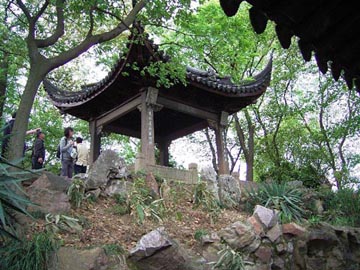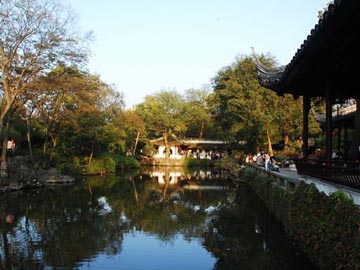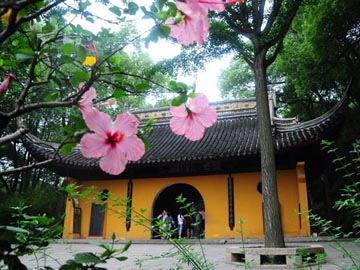|
Suzhou served the capital of Wu in the Spring and Autumn Period 2,500 years ago. Suzhou is famous for its picturesque scenery and exquisite private gardens. There were some old sayings about Suzhou: The heaven has paradise; the world has Suzhou and Hangzhou.
 |
 |
The
Pavillion of Surging Waves Garden |
The
Lion Grove Garden |
 |
 |
The
Humble Administration Garden |
The
Lingering Garden |
Most gardens in Suzhou were built in the Ming and Qing Dynasty. The gardens once numbered 200. The tranquil environment, refined layout, exquisite construction skills, and elegant structural style make Suzhou gardens renowned all over the world. The Humble Administration Garden, the Lingering Garden, Lion Grove and Pavilion of Surging Weaves are the 4 most famous gardens.
The Pavilion of Surging Waves is one very old garden which was built by a Song Dynasty scholar Named Su Zimei (1008-1048AD). He built a pavilion near the water and named the garden Pavilion of Surging Weaves.
Lion Grove was built in 1350 and believed to be designed by the famous painter Niyunlin in the Yuan Dynasty. There were beautiful rocks in the garden which were shaped like lions.
The Humble Administration Garden was built in 1522 in the Ming Dynasty. The owner of the garden was a high ranking official in the Ming Dynasty. He was demoted because of the confliction with his colleague in the court. Due to his failure in the officialdom he gave his garden the name of Humble Administration Garden. Much of the Garden is covered by water surface. The buildings in the garden either face water or are surrounded by water.
Lingering Garden built in the Qing Dynasty, is divided into several sections, each with buildings, rockeries, ponds, trees, flowers and grass. The different shaped doors and windows offer various views of the beautiful scenery beyond.
Besides the beautiful gardens, the Tiger Hill in Suzhou is also famous. It is in the suburb of the city. On that hill buried King Wu. According to a legendary story, one white tiger appeared beside the King’s tomb days after he was buried. There is a seven storied pagoda standing on the hill which has around 1,000 year’s history. Now the pagoda leans an angle of 15 degrees. It becomes a symbol of Suzhou.
 |
 |
The
Tiger Hill Tower |
The
Broken Beam Hall |
Silk Museum in Suzhou
Besides the beautiful scenery in Suzhou, silk, embroidery and brocade
in Suzhou are also world famous. It is pleasant to visit the Suzhou Silk
Museum. Suzhou was the silk capital of China. During the Tang (618-907)
and Song (960-1279) Dynasties, it was the silk producing center; in the
Ming (1368-1644) and Qing (1644-1911) dynasties most of the high quality
silk produced for the royal families was made by Suzhou silk weavers.
The Suzhou Silk Museum is divided into several parts: the Introductory
Hall, the Ancient Exhibit Hall, the Silkworm-Rearing Room, the Silk Weaving
Workshop, and the Exhibition Halls. There are also retail stores for purchasing
silk. It is worth visiting the Silk Museum in Suzhou. The tour in Suzhou
Silk Museum will offer you a good opportunity to learn the history of
Chinese silk and the sericulture of China. Of course you can purchase
high quality silk products there.
Generally speaking, one day tour in Suzhou is almost enough.
Mobile:(+86-1350 110 3837) Wechat:(13501103837) E-mail: chinasilkrug@msn.com